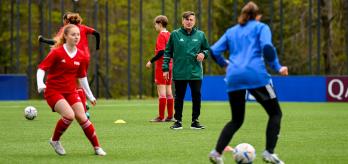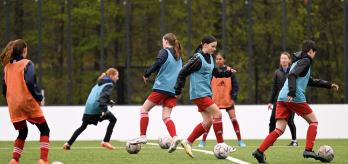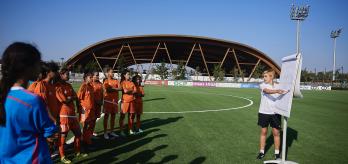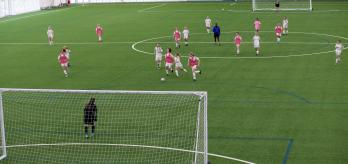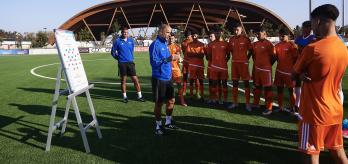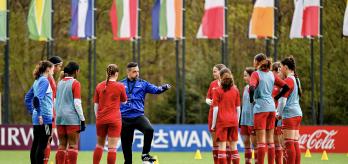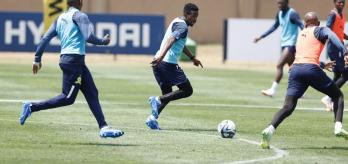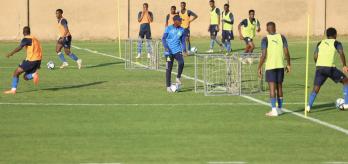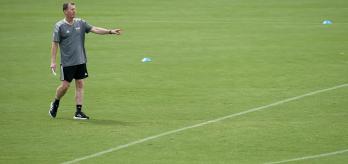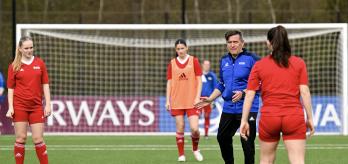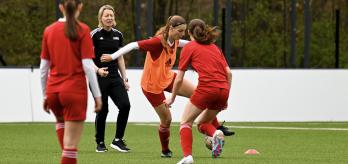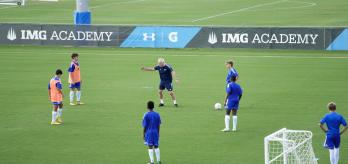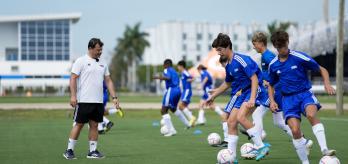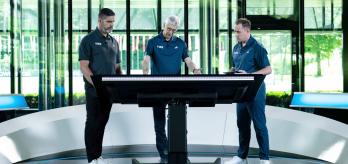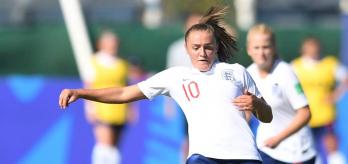Finding ways to penetrate and play forward can prove challenging when up against a compact defensive block. It is therefore essential for a team to be able to use the wide areas to play around the pressure and drag the opponents out of position. Tactically, a team might then look to draw the opponents towards one side of the pitch to quickly switch the play and exploit the space created on the weak side of the defence.
In this session, Lamia Boumehdi takes a group of 18 young female players through four drills that focus on switching the play to beat a defensive block. The drills pose different tactical problems such as how to draw opponents towards one side of the pitch, retain possession in tight areas, and exploit space. On a technical level, the session works on key elements such as short and long passing, one-touch passing, receiving long passes, and running with the ball at pace.
Session overview
Key coaching points
- Focus on using the whole width of the pitch and moving the ball from one side to the other to stretch the opposition and drag them out of position.
- Attack down one side of the pitch to attract pressure, which in turn creates space on the opposite side that the team can exploit through a switch of play.
- Improve players’ long-range passing and combination play so that they are able to quickly switch the play when necessary and exploit the space created on the opposition’s weak side.
Part 1: 5+5v6 – 3-zone game
The first exercise is designed to help players practise the technical elements that are pivotal to switching the play effectively. Three teams spread across a playing area divided into three zones. Two teams aim to keep possession and switch the play from one end zone to the other. By only allowing two players to press the team in possession, Boumehdi puts the players under limited pressure, so that they can focus on technical execution in order to achieve a good success rate and a high number of repetitions.
-
Mark out a 40x15 area and split it into 3 zones. The central zone is around 8m wide, while the other 2 zones are both around 16m wide.
-
The dimensions of the playing area need to be adjusted depending on numbers and player ability.
-
Split the players into 2 teams of 5 and 1 team of 6.
-
The team of 6 start inside the central zone.
-
The teams of 5 start in the end zones.
-
The teams of 5 aim to keep possession and move the ball from one end zone to the other without losing it to the third team.
-
Each team must complete between 3 and 5 passes before switching the play to the other end zone.
-
Only 2 players from the defending team can enter the end zones and press the team in possession at any given time. The remaining defenders have to stay inside the central zone.
-
If the defending team win the ball, possession restarts inside the opposite end zone and the teams keep their roles.
-
Players are limited to 2 touches.
-
If the defending team win the ball, they switch roles with the team that lost possession.
-
Should the game become too easy for the teams in possession, the coach can allow a third defender to press the ball.
-
Keep possession on one side of the pitch to attract pressure, which, in turn, can create space to exploit through a switch of play to the other side.
-
Move the ball quickly inside the zone to break the opposition’s press and use “up-back-through” combinations to switch the play.
-
Switch the play via lofted passes over the defence, which reduce the risk of an interception. Passes need to be weighted to give the receiver the best possible chance of taking a good first touch.
Part 2: 8v8 – pitch split into 4 vertical channels
In the second exercise, two teams of eight face off on a pitch split into four vertical channels with three mini-goals to score in on each side. Players are encouraged to use the whole width of the pitch when in possession to play around a compact block and switch the play quickly to exploit space once they have attracted pressure in one of the wide areas.
-
Mark out a 35x50m area.
-
Divide the area into 4 zones: the 2 wide zones are each 9m wide, while the central zones are each 16m wide
-
3 mini-goals are positioned at each end of the pitch, 1 at the end of each wide area and 1 in the middle of the central areas.
-
The team in possession are allowed to spread across all 4 channels, while the defending team are only allowed inside either wide area once the ball has entered it.
-
A goal scored in the central goal is worth 1 point.
-
A goal scored in 1 of the wide goals is worth 2 points if it comes after a switch of play from the other half of the pitch, but 1 point if there is no switch of play.
-
Attack down one side of the pitch to attract pressure and then switch the play to exploit the space created on the other side.
-
Use the whole width of the pitch to stretch the opposition, play around the block and exploit the space created on their weak side.
-
Quickly spread across the width of the pitch once possession is regained to make the pitch bigger.
-
Play forward quickly after a switch of play to exploit the space and deny the opposition time to recover into an organised defensive shape.
Part 3: 8v6 plus goalkeeper – attack v. defence
Boumehdi then sets up an attack v. defence drill on one half of the pitch, in which the attacking team benefit from an overload, allowing them to hone the combinations practised, as well as the technical and tactical elements introduced earlier in the session.
-
The exercise is played on half of the pitch.
-
Mark the wide areas using the outside line of the penalty area as a guide.
-
Footballs are kept in the centre circle to ensure the game flows.
-
The defending team are set up with a back 4 and 2 centre-midfielders.
-
The attacking team are set up with a front 3 (2 wingers and a centre-forward), 2 attacking midfielders, a defensive midfielder and 2 full-backs.
-
Each attack starts from the halfway line with the attacking team’s defensive midfielder.
-
Players work on 2 passing circuits: the first starts with a pass to a full-back, the second with a pass to an attacking midfielder.
-
If the ball goes out of play, a new attack starts.
-
If the defending team regain possession, they should try to cross the halfway line with the ball.
-
Players should try to use the whole width of the pitch to play around the defensive block.
-
Attack down one flank to attract pressure and then switch the play to exploit the space created on the other side.
-
Move the ball quickly and combine on one side of the pitch to attract the opposition. This will then create space behind the defensive line and on the other side of the pitch, and players can then quickly switch the play and exploit the space to carve out goalscoring opportunities.
-
Focus on improving short and long passing techniques, including one-touch passing.
-
Improve players’ tactical understanding and passing selection. Passes should be hit with pace when players are trying to exploit space, so that they can deny the opponents time to recover defensively. On the contrary, passes must be softer if players are trying to attract pressure, so that they can draw the opponents out of position and create space.
Part 4: 8v8 plus goalkeepers
The session ends with a small-sided 8v8 plus goalkeepers game, which allows players to put the technical and tactical elements learnt throughout the session into practice in a match environment.
-
The playing area covers the full width of a pitch and two thirds of its length.
-
Both teams are set up in a 3-2-3 formation with a goalkeeper.
-
The wide channels are marked with cones.
-
Players are limited to 3 touches.
-
A team cannot make more than 3 consecutive passes inside the same wide channel.
-
A goal is worth 3 points if it follows a switch of play.
-
The team in possession should usethe whole width of the pitch to increase the chances of playing around the opposition’s defensive block.
-
Attack down one side of the pitch to attract pressure and then switch the play to exploit the space created on the other side.
-
Move the ball and combine on one side of the pitch to attract the opposition. This should create space behind the defensive line and on the other side of the pitch, so that players can quickly switch the play and exploit the space to carve out goalscoring opportunities.
-
Improve players’ tactical understanding and passing selection. Passes should be hit with pace when players are trying to exploit space, so that they can deny the opponents time to recover defensively. On the contrary, passes must be softer if players are trying to attract pressure to draw the opponents out of position and create space.
-
Play back inside if a forward pass is not possible to avoid being closed down by the opposition towards the touchline, and quickly switch the play to exploit the space created on the weak side.














